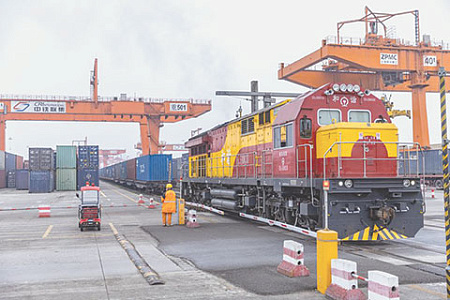
The crisis in Ukraine and Houthi attacks on cargo ships in the Red Sea are prompting Beijing to seek new trade routes to the EU– China’s main trading partner. The solution to this problem will become even more relevant if Donald Trump continues to squeeze China out of markets in the Americas with tariffs. In December, China, Kyrgyzstan and Uzbekistan announced the start of construction of a railway that will run through the Caspian Sea and Turkey, allowing China to logically become closer to Europe. The reorientation of routes from China to Europe may harm the Russian economy, but it will not affect relations between Beijing and Moscow.
There was talk of a new railway line 30 years ago, writes The Economist magazine. The decision to bring the idea to life appeared only after the start of the SVO in Ukraine. Before that, the main railway line from China to Europe went through Russia, sometimes through Kazakhstan.
The military conflict in Ukraine has changed the picture. European carriers, unsure of the safe transportation of goods and unhappy with the increase in insurance prices, began to avoid this route. The sanctions imposed on Russia also contributed to an increase in the duration of the delivery of goods through Russia.
Freight companies began to redirect cargo to the ports of Kazakhstan on the Caspian Sea, that is, they began to use the “trans-Caspian route”, which is also called the Middle Corridor. And if we add a line through Kyrgyzstan and Uzbekistan, then the Average corridor to Europe will become even shorter. In June 2024, the Chinese government signed an agreement with these countries to lay a 520 km long railway line.
As the authoritative British magazine further recalls in its commentary, Beijing said that its relations with Moscow are based on the principle of “back to back, shoulder to shoulder.” In other words, the ties between the two powers are strong. But when it comes to exports to Europe, China prefers not to depend on its best friend. The Chinese do not turn their backs on Russian leaders. They view Russia as a key component in building global infrastructure based on the Belt and Road Initiative. This initiative was initiated by Xi Jinping in 2013, when he became the leader of the People’s Republic of China. Moreover, one of the motivating motives for this was the desire to expand railway links with Russia and Central Asia. Indeed, in the event of a war with the United States, they could supply China with energy resources and raw materials. And now China’s enthusiasm for the Middle Corridor is fueling a desire to increase exports. After all, it is the driving force of the economy. It is especially important to preserve it in conditions when economic growth has become unstable.
However, the railway tracks between China and Russia remain extremely important for both countries. Through these lines, China supplies Russia with the equipment necessary for the production of weapons. Naturally, freight turnover between the two countries by rail has increased, while with the EU, on the contrary, it has decreased. Beijing is aware that a workaround can provide easier access to the European market, especially for goods that are time-sensitive. That’s why he made deals with Kyrgyzstan and Uzbekistan.
Of course, the sea route is theoretically much more profitable than the land route. As Yunus Sharifli, an expert at the Chinese organization China Global South Project, says, trains will never replace ships. One ship can take on board hundreds of times more containers than a train. Despite the attacks by the Houthis, transportation by sea remains much more profitable than by land. A number of companies even began sending ships to Europe along the route around the Cape of Good Hope, so as not to expose them to the risk of coming under fire.
The construction of the railway through Kyrgyzstan and Uzbekistan will take several years. According to information from Bishkek, China has provided Kyrgyzstan with a loan of $2.35 billion. The countries through which the Middle Corridor passes and China are working to improve it. Russia is not involved in these works. Although the Middle Corridor is shorter than the route through Russia, it takes longer to deliver goods along it. It is necessary to cross several borders, transfer cargo to ships in the Caspian Sea or on an alternative route on the Black Sea.
Nevertheless, the PRC no longer considers the Middle Corridor as a simple addition to the route through Russia. According to a study by the Institute of Modern International Relations of China, which is considered an arm of the Ministry of State Security, this route is becoming “the main channel for cargo transportation and is gaining strategic importance.” And Korkan Tugrul, director of the German logistics company Rhenus in Istanbul, says that transportation along this corridor is still 35% more expensive than through Russia. Nevertheless, more and more goods from China are being delivered along this route.
In an interview with NG, Vasily Kashin, a senior researcher at the Higher School of Economics, noted: “This is not a plan to bypass Russia by rail. The line through Kyrgyzstan and Uzbekistan has been under construction since 2023, primarily to ensure the supply of Uzbek products to China. It can be used in the future to deliver Chinese goods to Europe. But it is not a fact that this idea is being realized. The Western media is making a fuss about this project in order to cast a shadow on Russia’s relations with China.”
